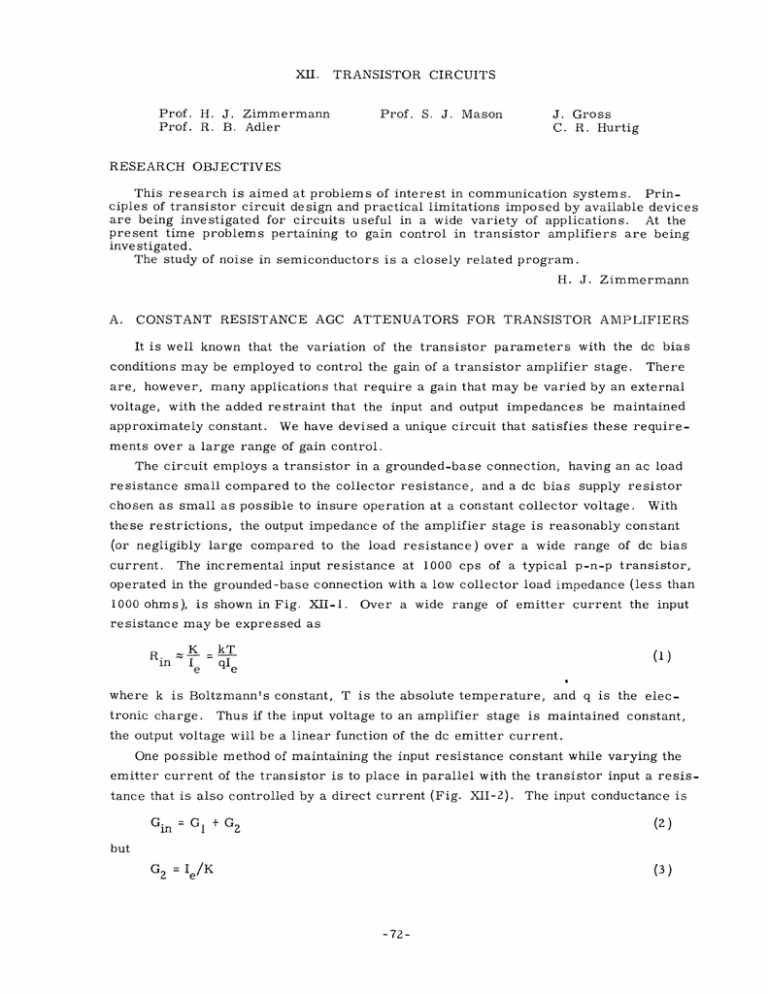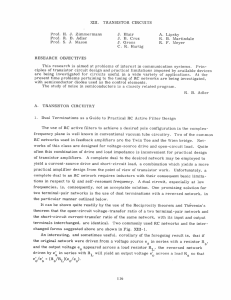XII. TRANSISTOR CIRCUITS Prof. H. J. Zimmermann
advertisement

XII. TRANSISTOR CIRCUITS Prof. H. J. Zimmermann Prof. R. B. Adler Prof. S. J. Mason J. Gross C. R. Hurtig RESEARCH OBJECTIVES This research is aimed at problems of interest in communication systems. Principles of transistor circuit design and practical limitations imposed by available devices are being investigated for circuits useful in a wide variety of applications. At the present time problems pertaining to gain control in transistor amplifiers are being investigated. The study of noise in semiconductors is a closely related program. H. J. A. CONSTANT RESISTANCE AGC ATTENUATORS Zimmermann FOR TRANSISTOR AMPLIFIERS It is well known that the variation of the transistor parameters with the dc bias conditions may be employed to control the gain of a transistor amplifier stage. There are, however, many applications that require a gain that may be varied by an external voltage, with the added restraint that the input and output impedances be maintained approximately constant. We have devised a unique circuit that satisfies these require- ments over a large range of gain control. The circuit employs a transistor in a grounded-base connection, having an ac load resistance small compared to the collector resistance, and a dc bias supply resistor chosen as small as possible to insure operation at a constant collector voltage. these restrictions, the output impedance of the amplifier stage is reasonably constant (or negligibly large compared to the load resistance) over a wide current. With range of dc bias The incremental input resistance at 1000 cps of a typical p-n-p transistor, operated in the grounded-base connection with a low collector load impedance (less than 1000 ohms), is shown in Fig. XII-1. Over a wide range of emitter current the input resistance may be expressed as R. in K Ie kT qI e (1) where k is Boltzmann's constant, T is the absolute temperature, tronic charge. and q is the elec- Thus if the input voltage to an amplifier stage is maintained constant, the output voltage will be a linear function of the dc emitter current. One possible method of maintaining the input resistance constant while varying the emitter current of the transistor is to place in parallel with the transistor input a resistance that is also controlled by a direct current (Fig. XII-2). Gin = G 1 + G2 The input conductance is (2) but G 2 = Ie/K (3) -72- UNIT NO.I I 10-6 10-4 DC EMITTER CURRENT (AMP) Fig. XII-1 Incremental input resistance of typical ck7l21's in the grounded-base connection. E GC I2 V , I .L Fig. XII-2 Constant-resistance Fig. XII-3 attenuator. Practical constant-resistance attenuator. e =I F -I Fig. XII-4 Alternate arrangement of a practical constant-resistance attenuator. -73- (XII. TRANSISTOR CIRCUITS) Gin = constant Thus the conductance G 1 must have the following characteristic I G 2 = Gin - G2 = Gin - 2 in 2 in G.in K - I e K K e (4) It is seen that the required characteristic of the conductance G 2 is identical with that of the transistor. That is I2 G2- K (5) where 12 = Gin K - I e or (6) 2 = IF - I e Two practical arrangements of the circuit are shown in Figs. XII-3 and XII-4. The current sources are approximated by voltage sources in series with resistors large in value compared to the desired input resistance. For many applications, resistors as small as 20, 000 ohms are sufficient to satisfy this requirement. shown in Fig. XII-5 apply to the circuit of Fig. XII-3. The experimental data The output voltage is a linear function of the control bias within an accuracy of 10 per cent over a range of at least 40 db, while the input impedance varies by less than ±10 per cent over the same range. The bandpass amplifier in Fig. XII-6 was constructed for a nominal center frequency of 1. 7 Mc/sec. The data in Fig. XII-7 show that a bandwidth variation of approximately ± 6 per cent accompanies a 54-db variation in gain. The same amplifier operated without the diodes shows a bandwidth variation from 300 kc/sec to 70 kc/sec accompanying a 48-db variation in gain. Thus the diodes improve the operation by a factor of approximately 40. It should be noticed that the center frequency of the amplifier changed from 1. 74 Mc/sec to 1. 64 Mc/sec along with the 54-db gain variation. Since this variation does not occur when the diodes are removed, the change in center frequency is attributed to the diffusion capacitance of the silicon diodes. By a substitution measurement tech- nique, the change in diode capacitance was found to be 250 4if from zero bias to the maximum bias of 100 pa. The effective hole lifetime of the silicon diodes was calculated from this information to be approximately 0. 15 psec, which seems reasonable enough to support the explanation proposed above. A bandpass amplifier, centered at 8. 0 Mc/sec, with a nominal bandwidth of 900 kc/sec, has also been built and tested. A gain variation of 42 db produced a band- width variation of 11l per cent and a decrease of center frequency from 8. 4 Mc/sec to -74- 0.1 1.0 10 100 EAGC (VOLTS Fig. XII-5 Gain and input resistance of a practical constant-resistance attenuator. AGC ~IVL/AI ~I TC Ra22K ALL TRANSISTORS ARE PHILCO SBT L 5106 Fig. XII-6 Bandpass amplifier incorporating two constant-resistance attenuator stages. -75- (XII. TRANSISTOR CIRCUITS) aI G Lii Yr) 0'2 0 z Lii D w a: LIi Cr Ut_ T z Ld 0 Z3 0 o Uj LO zI m m zc) -J Cr -3 -2 AGC VOLTAGE (VOLTS) Fig. XII-7 Characteristics of constant-resistance attenuator in an i-f amplifier. 7. 83 Mc/sec. The change in bandwidth in this case is partially attributed to the fact that the input impedance of the transistor (even at an emitter current of 120 pa) is affected by the base resistance and the collector load impedance. The change in center frequency is caused by the diffusion capacitance of the silicon diode. Even with these limitations, the use of the constant-resistance attenuators reduces the bandwidth variation by a factor of 10, compared to the same amplifier with the diodes disconnected. Future work will include amplifier design employing tetrodes to reduce the feedback across the base resistance. A study of available diodes will be made, with the hope of reducing the effects of diffusion capacitance. The possible variations of the age circuit are too numerous to illustrate. It is of interest to mention that the transistors used in the age stages may be connected to obtain dc gain for the age signal. If one of the transistors is connected with a large external -76- (XII. base resistance, by-passed for alternating current, TRANSISTOR CIRCUITS) it may be operated in the grounded- base connection for ac signals and in the grounded-emitter connection for the agc signal. The temperature stability of such a circuit is subject to all the limitations of a normal grounded-emitter connection and is therefore less desirable than a grounded-base connection. B. THE OPERATIONS OF MULTIPLICATION AND DIVISION The data shown in Fig. XII-5 indicate that the constant-resistance attenuator may be used to vary the amplitude of a carrier signal as a linear function of a dc control signal. A diagram of a circuit that employs a constant-resistance attenuator to obtain the operation of multiplication and/or division is shown in Fig. XII-8. e S = a i. in = in in s e iR R From this figure, we have L rd + r i I sI (7) I (8) Thus the amplitude of the carrier is a linear function of the current I proportional to the current I F . 1 and inversely If two dc voltages are to be multiplied, two constant- resistance stages may be cascaded; or one stage may be driven from a balanced modulator, controlled by one of the dc signals. It is interesting to notice that by using a current source to inject the carrier signal (Fig. XII-8), the temperature-dependent term of the input resistance is eliminated from the expression for the output voltage. If the temperature range over which the device must operate is small, a voltage source may be employed. The accuracy of the multiplication circuit is difficult to evaluate. At the present time, preliminary experiments on devices employing resistors of less than 100 kilohms as current sources indicate an over-all accuracy of better than ±10 per cent over a 40db dynamic range. Higher accuracy results from a reduction of the dynamic range. If the amplitude of the carrier signal is to be varied by a dc voltage of variable polarity, the auxiliary diode may be replaced by a transistor that is the complement of the original. Fig. XII-8 Constant-resistance attenuator used to obtain the operations of multiplication and division. By subtracting the outputs of the two transistors, the desired function will be achieved. C. R. Hurtig -77-









